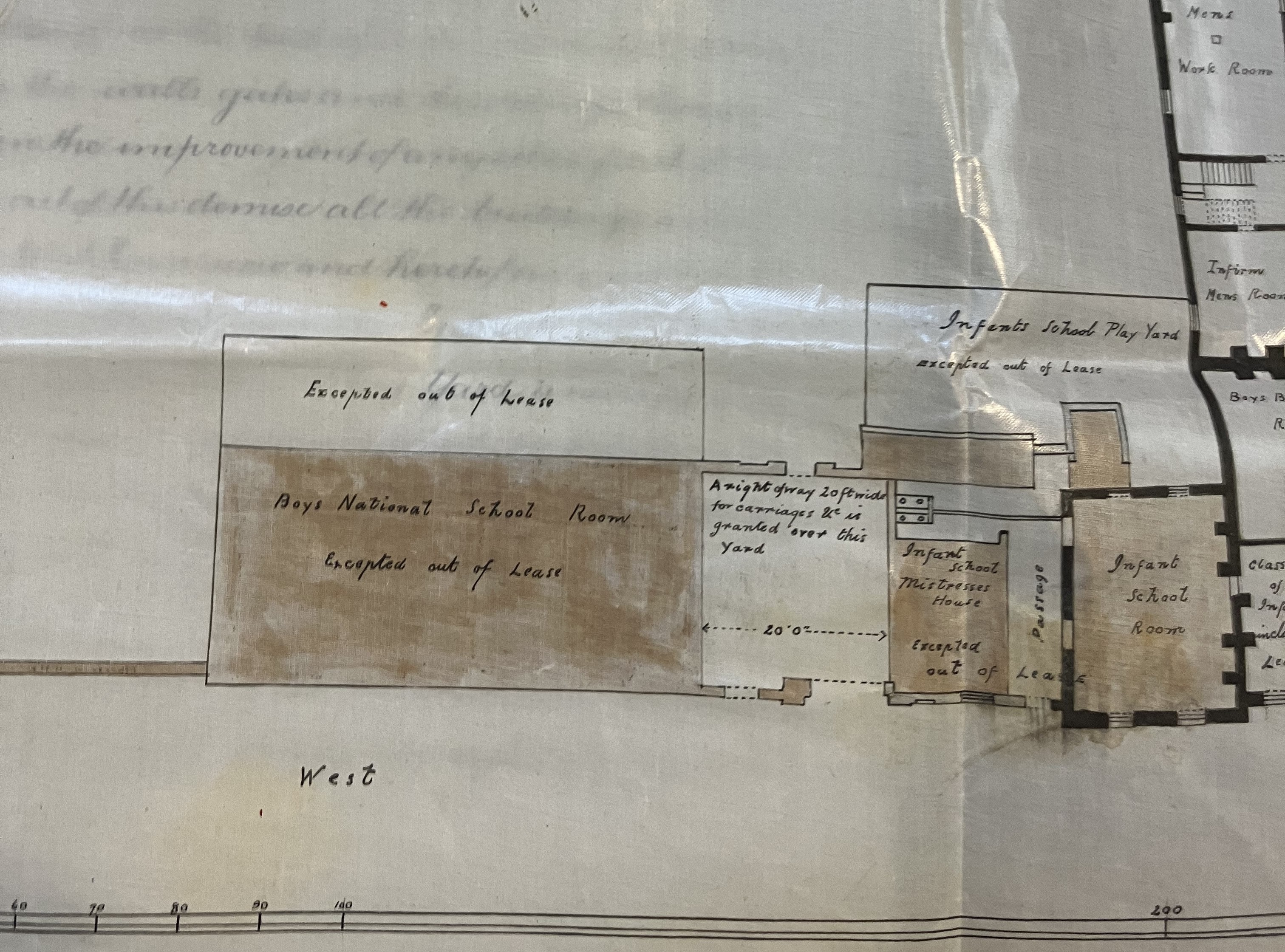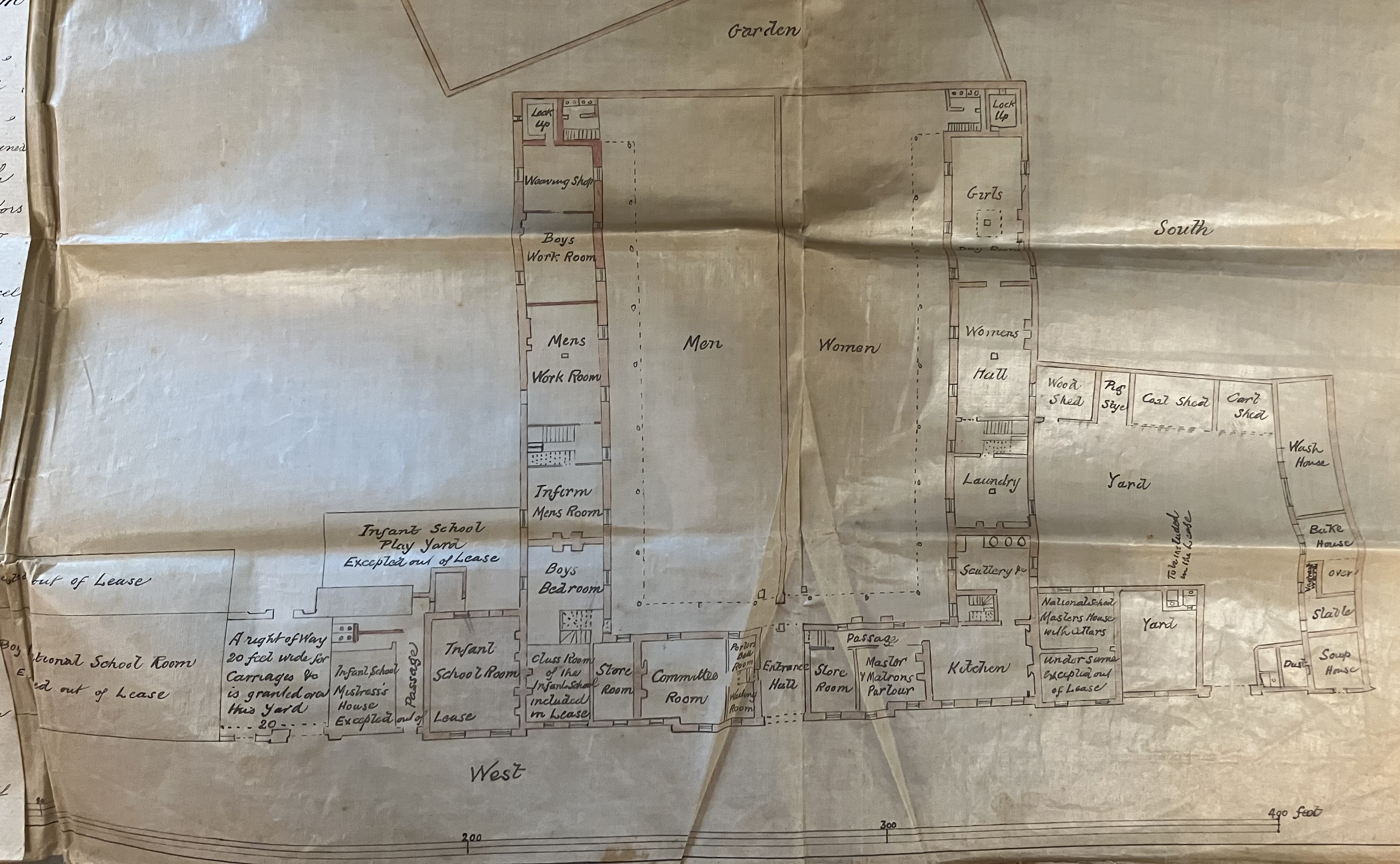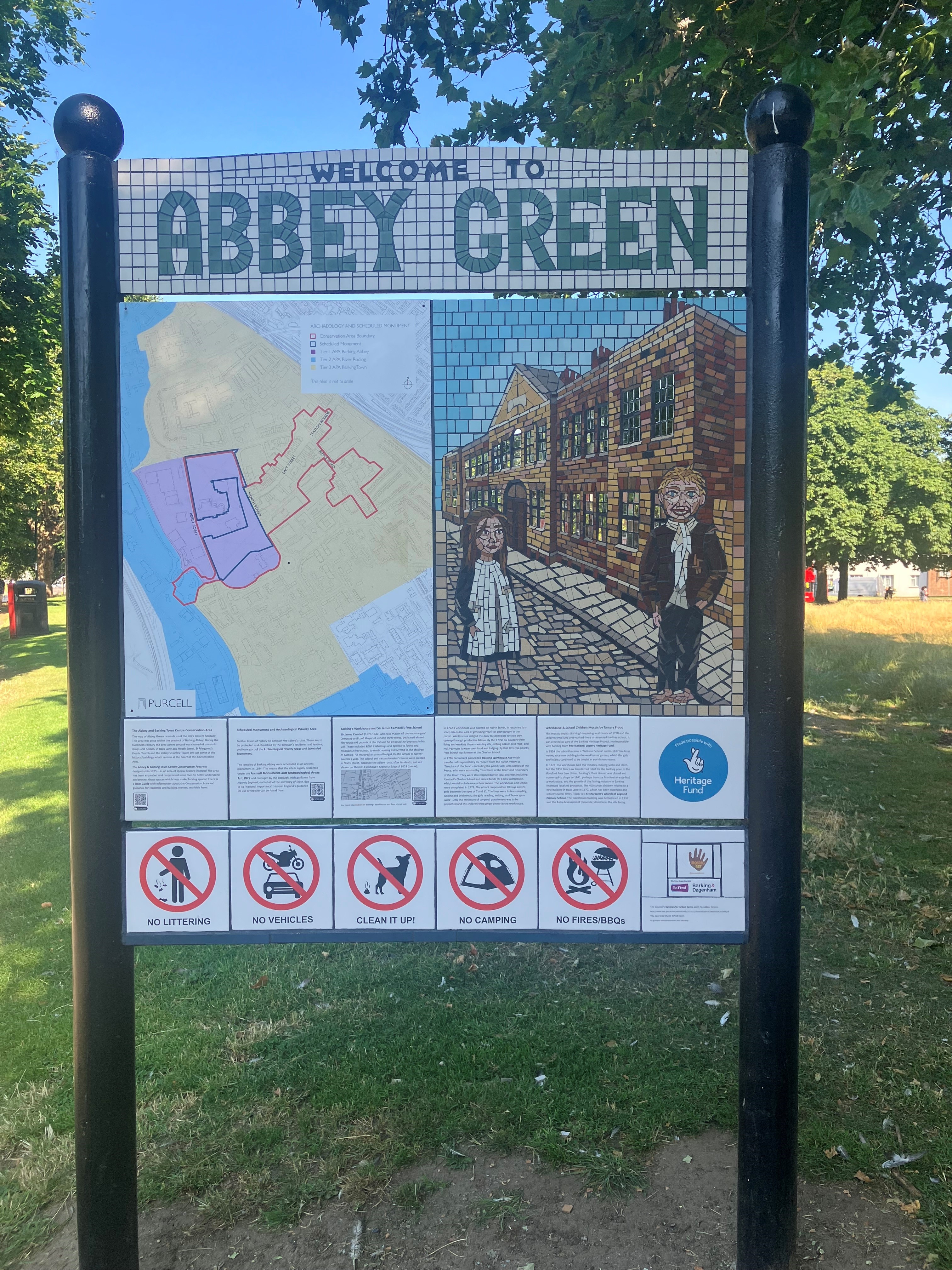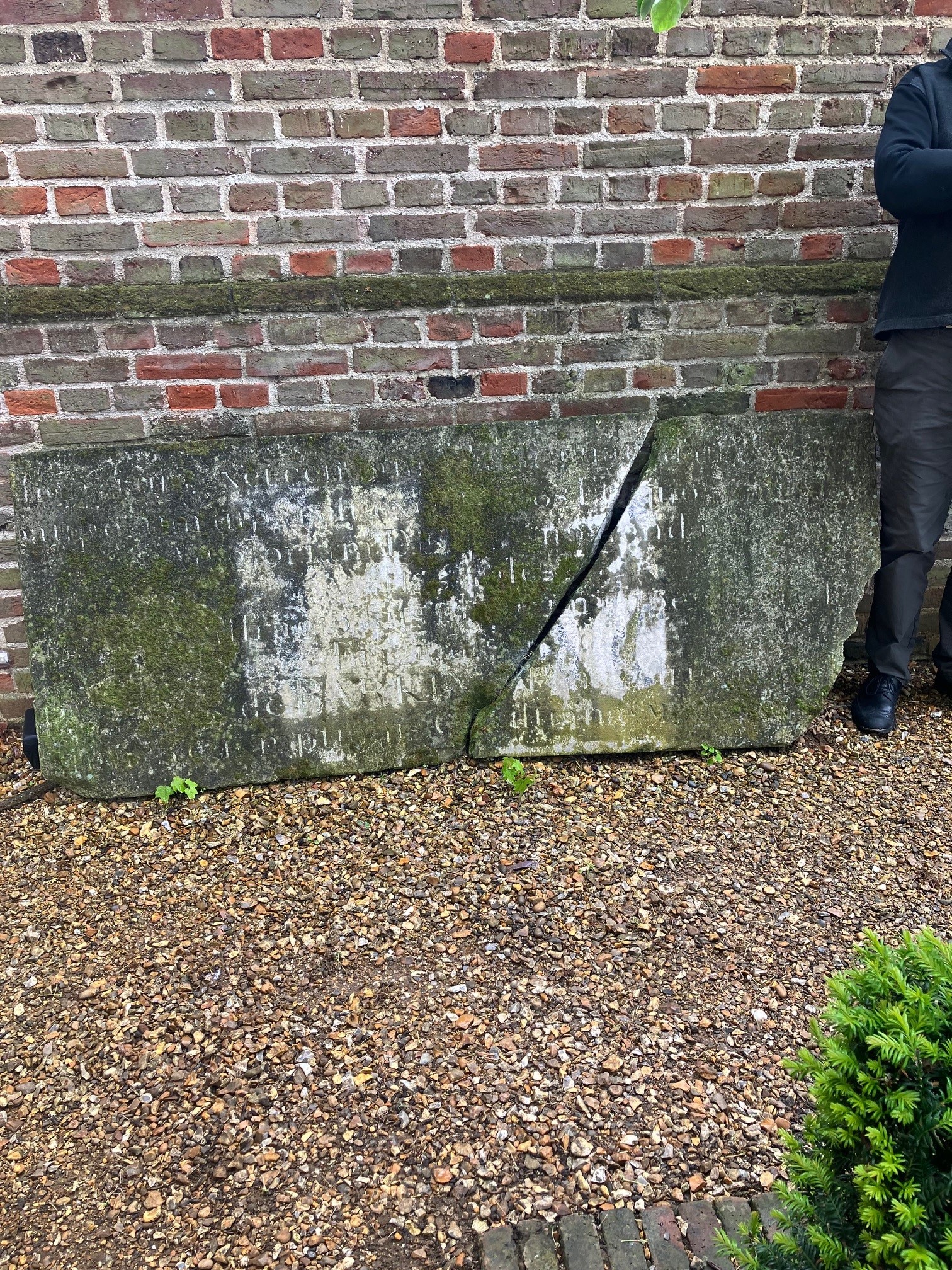Barking Workhouse and Sir James Cambell's free school
A charity providing free schooling for children was bequeathed and funded by former Lord Mayor - Sir James Cambell, in his will of 1642, and subsequently built on North Street, in Barking. It appears on Thomas Fanshawe’s map of 1653 as a 'Free School.' This would become the site of the 1788 Workhouse.
 From Thomas Fanshaw's Manorial Map of 1653There was a large rise in the Poor rate from £521 in 1694 to £923 by 1714 -consequently in 1722 a workhouse opened in ‘four leasehold tenements on North Street’ (Richard Tames, 2002) - which obliged the poor to contribute to their own upkeep, through productive labour!
From Thomas Fanshaw's Manorial Map of 1653There was a large rise in the Poor rate from £521 in 1694 to £923 by 1714 -consequently in 1722 a workhouse opened in ‘four leasehold tenements on North Street’ (Richard Tames, 2002) - which obliged the poor to contribute to their own upkeep, through productive labour!
By 1734 all residents receiving poor relief (parish vestry benefits) were obliged to enter the workhouse but the policy was not enforced in Barking and many out-pensioners still received ‘cash & kind’ instead.
By the 1770s 50 paupers were accommodated at Barking's workhouse - winding silk, picking oakum/old rope, making mops etc. On Andre & Chapman’s Map of 1771 – the Free School is shown as the ‘Charter School’. By 1779 the Poor Rate was costing £2000.
 Andre & Chapman's Map of 1771 showing the Charter School before the new workhouse was builtIn 1786 Parliament passed the Barking Workhouse Act which transferred local responsibility for ‘Relief’ from the Parish Vestry to a board of six ‘Directors of the Poor’ – including the vicar of the parish, JPs and others, who were assisted by ‘Guardians of the Poor’ and ‘Overseers of the Poor’ – who were helping the 'casual poor'. This new form of governance design to increase funding for a new workhouse. The board took over local charities, including Cambell’s Charter School, and funds were raised for building a larger workhouse, which would also include school rooms!
Andre & Chapman's Map of 1771 showing the Charter School before the new workhouse was builtIn 1786 Parliament passed the Barking Workhouse Act which transferred local responsibility for ‘Relief’ from the Parish Vestry to a board of six ‘Directors of the Poor’ – including the vicar of the parish, JPs and others, who were assisted by ‘Guardians of the Poor’ and ‘Overseers of the Poor’ – who were helping the 'casual poor'. This new form of governance design to increase funding for a new workhouse. The board took over local charities, including Cambell’s Charter School, and funds were raised for building a larger workhouse, which would also include school rooms!

Cambell's Free School was pulled down in 1786-8 to make way for the new workhouse which was built on land adjoining it, on North Street, and completed in 1788. The new workhouse cost £4000 to build, it was one of the largest in Essex and a very imposing building.
 Bamford's Sketch of barking workhouse, 1905, with signage in the pediment.
Bamford's Sketch of barking workhouse, 1905, with signage in the pediment.In the same year the directors reopened the free school for 20 boys and 20 girls between the ages of 7 and 11. The boys were to learn reading, writing and arithmetic, the girls reading, writing, and 'home spun work'. Only a minimum of corporal punishment was to be permitted and the children were to be given dinner in the workhouse. In 1792 the school master was given permission to take 12 private pupils and to hold an evening class for girls. See Victoria Histories - https://www.british-history.ac.uk/vch/essex/vol5/pp235-248#google_vignette
In 1810 Cambell’s School was reorganised by a local committee – paying a master and mistress (increased pay) to teach 20 boys and 20 girls and provide a Sunday School; money for the pupils’ clothes was also provided. By 1818 there were 200 children, perhaps reflecting the rapid population increase at this time, and the efforts of Mr Lodge to increase the number of students receiving a free education. Reverend Oliver Lodge, of St Margaret's Parish Church [possibly the namesake of Lodge Avenue and author of published sermons] raised the number of children being educated at the school between c1809-1836 - they rose from 40 to 400 during this period.
In 1824 the school was merged with the National Society (established by the Church of England in 1811) – becoming a 'National School'! As shown on the plans from 1840s.
 Boys National School and Infants School adjacent to the workhouse in the plans shown in Victorian Conveyance documents
Boys National School and Infants School adjacent to the workhouse in the plans shown in Victorian Conveyance documents Victorian plans show the ‘National School’ with ‘Boys’ and ‘Infants’ written across separate rooms facing North Street. The School Boys were rehoused in 1827 – in a this building built in the workhouse garden – on the site of Cambell’s original School. This shown on the 1840s plans. Whilst the infants continued to be taught on the other side of the goods entrance. The only room for girls is shown within the Workhouse and not as part of the school, so girls maybe only attended school as infants at that time...
 Victorian plans of workhouse site, including Boys' National School, Infants' School and workhouse rooms and dormitories, including a room for girls, a division of men and women and a house for school master.
Victorian plans of workhouse site, including Boys' National School, Infants' School and workhouse rooms and dormitories, including a room for girls, a division of men and women and a house for school master.The workhouse had 250 inmates by 1828, making [jute] sacks, and later cloth etc.
The New Poor Law of 1836 – meant relief for the Barking Poor was thereof transferred to Romford Poor Law Union. Details are available on Romford’s (sister) Workhouse, which became Oldchurch Hospital – some of its original buildings remain in the residential development on the site. See: The Workhouse in Romford, Essex
Following the change of management, and perhaps because Romford had its own large workhouse, around 1841, Barking’s workhouse was converted to half a dozen shops. Tames reminds us that, the expansion of the fishing industry, which greatly improved employment opportunities in Barking, may have been a positive reason why Barking also had less of a requirement for a workhouse at the start of the Victorian era.
 Photograph of old Workhouse building - used as shops c.1920
Photograph of old Workhouse building - used as shops c.1920
Barking's 'Poor House' as it was also known, was leased to James Withers, who later built-out the plot, without removing the exterior façade of the building along North Street, which housed the shops. He added residential housing - Trafalgar and Nelson Street, which were built in the workhouse grounds and represent further evidence of rising prosperity in Barking, and increased need for housing, where work was readily available in fishing and associated industries. Mark Watson reminds us that these two streets were known as the most patriotic streets in Barking, due to the loss of young men living there in World War I - 1914-18…
There was a 99 year lease from Romford PLU issued in 1848 – perhaps that is when these houses were built, alongside the earlier shops within the main workhouse building. The shops included King Harry Beer House, which was leased by a relative of Withers and part of the main building (perhaps former school rooms, retaining their educational purpose) later housed Barking’s first library!
In 1872 a new school building, costing about £4,000, was erected in Back Lane. This was enlarged in 1875 and again in 1889. In 1896 a new infants department was built, also in Back Lane. Cambell's rent-charge continued to be paid to the school until 1898, when it became part of Barking and Ilford United Charities. Since then this income has been used for the general purposes of those charities. The school changed its name from a National School to a Church of England School during the late nineteenth or early twentieth century, perhaps following Balfour's Education Act of 1905.
In 1948 the school was re-organized for juniors and infants and in 1950 it was granted Voluntary Aided status. The school was rebuilt again in the 1960s and at one point known as St Mary's (named after the Abbey Church). Today it is known as St Margaret’s Church of England Primary School.
 Mosaic and tile sign by Tamara Froud commemorating Barking Workhouse and its links with the nearby St Margaret's CofE Primary School
Mosaic and tile sign by Tamara Froud commemorating Barking Workhouse and its links with the nearby St Margaret's CofE Primary SchoolThe 1788 workhouse building was demolished in 1936! The words above the workhouse entrance rather dramatically and perhaps disconcertingly read, in Latin, ‘This house of industry at the sole expense of the inhabitants of Barking is to provide and protect the industrious and to punish the idle and wicked’ The stone plaque was retained and spent many years in Eastbury Manor House's kitchen garden, but in 2025 it was removed for restoration and will be re-installed on St Margaret's School's wall, opposite the site of Barking Workhouse (now Asda) as part of a restoration and engagement project funded by Heritage of London Trust.
 Eighteenth-century, inscribed workhouse stone signs at Eastbury Manor House
Eighteenth-century, inscribed workhouse stone signs at Eastbury Manor HouseThank you to Valence House Local Studies Library and Archive for the historic images used and for Sue Hamilton and Heritage Volunteers who undertook research on Barking Workhouse, If you have further information to share, please contact: simone.panayi@befirst.london
Barking Workhouse by Sue Hamilton
North Street Stories - The Workhouse by Sue Hamilton
A workhouse was opened in Barking in 1722 in four tenements in North Street.
An inspection report of March 1725 gives an impression of daily life for the inmates in the workhouse:-
“Their employment consists of picking Ockam (this was old rope and cable or Junk purchased from merchants and teased out into fibres to be resold to shipbuilders for mixing with tar to seal the lining of wooden craft. This could also be used to make matting or bandaging). The women knit and mend stockings for the whole family, make beds and keep the house clean, and sometimes pick Ockam.
The Steward and his wife have the government of the family, he buys the food at the market and she prepares it. There is a small infirmary built on the back but the people are generally in such good health that it has little use.”
There were three meals a day- breakfast, consisting of broth or porridge. Dinner included meat four times a week usually beef, sheep’s head, or ox cheek. Supper was left-overs from dinner or bread and butter with cheese and unlimited bread and beer!
The civil parish of Barking was divided into four wards. Barking Town, Ripple, Chadwell and Ilford. The Barking Workhouse Act passed in 1786 appointed six Directors of the Poor to be responsible over the four Guardians (one from each ward) and Overseers for Poor Relief. The original Directors were:
The Rev Peter Rashleigh, vicar
Mr Bamber Gascoyne senior of Byfrons
Mr Bamber Gascoyne junior of Byfrons
George Spurrell, farmer of Roden Lodge
Thomas Pittman, farmer of Loxford Hall
Edward Hulse, Lord of the Manor
A new building could accommodate over 250 inmates. It was one of the largest parish workhouses in Essex, completed in 1788 on a site which had previously housed Mr Rayment’s Brewhouse & Malthouse and an old school building. The brick building, which cost £4,000, had a frontage of 140 feet, was two storeys high, plus a basement, with two side wings, forming a square with piazzas (supported by plain pillars) where the inmates could enjoy their recreation periods. It contained an apartment for the Master and Matron, committee room, store rooms and a long room for the looms (spinning and sack making were two of the occupations the inmates performed). The bedchamber was on the first floor. A Latin inscription on the pediment translated as “This House of Industry was built at the sole expense of the inhabitants of Barking to provide for and protect the industrious and to punish the idle and wicked”. This inscription was salvaged when the workhouse was demolished and is now displayed in the kitchen garden at Eastbury Manor House.
The Grammar School and Workhouse at Barking 1799
From the Workhouse (where the Asda supermarket is today) looking diagonally across the junction with London Road could be seen the site of the Barking House of Correction/Bridewell from 1792 until it closed in 1831. Also the site of the old North Street Police Station from 1842 until it was demolished in 1955.
The new Union Act of 1837 abolished local workhouses and the inmates were transferred to the care of the Romford Union. From 1836 to 1838 the Barking workhouse was leased to Romford Poor Law Union for two years until their own building was completed. The vacated building was let and converted into shops in 1841.
There was evidence part of the building was used as a mortuary. The London Morning Advertiser reported on 5th January 1853.
“Suspected suicide: The naked body of a young man found in the Thames and the body removed to Barking Workhouse to be owned”.
The Western Mail on 5th September 1878 reported the sinking of The Princess Alice Paddle Steamer disaster at Woolwich on 3rd September with the loss of hundreds of lives. No less than 29 bodies were recovered on the shore of The Beckton Gas Company and they were removed to the Barking Workhouse about a half a mile away.
Barking was the first place in Essex to adopt the Public Libraries Act in 1888. After long negotiations space in the north-west corner of the old workhouse building was allocated for the library. Repairs and renovations were supervised by Mr. C.J. Dawson, the Surveyor to the local board. On the 31st May 1889 the new Barking Public Library was officially opened. In 1894 the library transferred to the Public Offices in East Street.
The workhouse was finally demolished in 1936.
Bamford's depiction of the Workhouse in 1905
- There are no stories to display. Why don't you share one?
